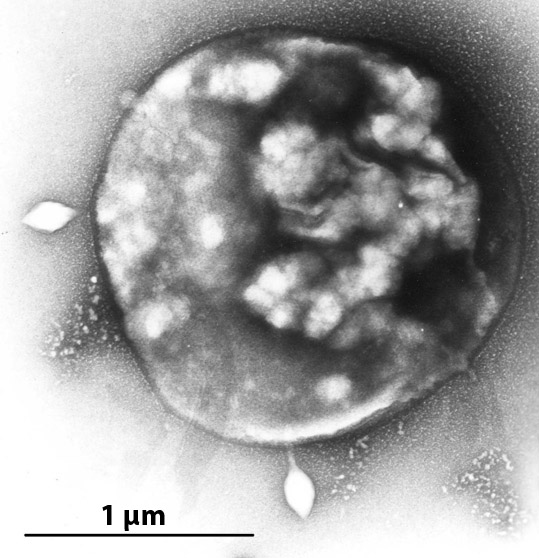|
Globuloviridae
''Globuloviridae'' is a family of hyperthermophilic archaeal viruses. Crenarchaea of the genera Pyrobaculum and Thermoproteus In alpha taxonomy, taxonomy, ''Thermoproteus'' is a genus (biology), genus of the Thermoproteaceae. These prokaryotes are thermophile, thermophilic sulphur-dependent organisms related to the genera ''Sulfolobus'', ''Pyrodictium'' and ''Desulfuroc ... serve as natural hosts. There are four species in this family, assigned to a single genus, ''Alphaglobulovirus''. Taxonomy The family contains one genus which contains four species: * ''Alphaglobulovirus'' ** '' Alphaglobulovirus PSV'' ** '' Alphaglobulovirus PSV1'' ** '' Alphaglobulovirus TSPV1'' ** '' Alphaglobulovirus TTSV1'' Structure Virions in the ''Globuloviridae'' are spherical and enveloped. The diameter is around 100 nm. Genomes are linear dsDNA and non-segmented, around 20–30kb in length. Life cycle Viral replication is cytoplasmic. DNA-templated transcription is the method of trans ... [...More Info...] [...Related Items...] OR: [Wikipedia] [Google] [Baidu] |
Globuloviridae
''Globuloviridae'' is a family of hyperthermophilic archaeal viruses. Crenarchaea of the genera Pyrobaculum and Thermoproteus In alpha taxonomy, taxonomy, ''Thermoproteus'' is a genus (biology), genus of the Thermoproteaceae. These prokaryotes are thermophile, thermophilic sulphur-dependent organisms related to the genera ''Sulfolobus'', ''Pyrodictium'' and ''Desulfuroc ... serve as natural hosts. There are four species in this family, assigned to a single genus, ''Alphaglobulovirus''. Taxonomy The family contains one genus which contains four species: * ''Alphaglobulovirus'' ** '' Alphaglobulovirus PSV'' ** '' Alphaglobulovirus PSV1'' ** '' Alphaglobulovirus TSPV1'' ** '' Alphaglobulovirus TTSV1'' Structure Virions in the ''Globuloviridae'' are spherical and enveloped. The diameter is around 100 nm. Genomes are linear dsDNA and non-segmented, around 20–30kb in length. Life cycle Viral replication is cytoplasmic. DNA-templated transcription is the method of trans ... [...More Info...] [...Related Items...] OR: [Wikipedia] [Google] [Baidu] |
Archaeal Viruses
An archaeal virus is a virus that infects and replicates in archaea, a domain of unicellular, prokaryotic organisms. Archaeal viruses, like their hosts, are found worldwide, including in extreme environments inhospitable to most life such as acidic hot springs, highly saline bodies of water, and at the bottom of the ocean. They have been also found in the human body. The first known archaeal virus was described in 1974 and since then, a large diversity of archaeal viruses have been discovered, many possessing unique characteristics not found in other viruses. Little is known about their biological processes, such as how they replicate, but they are believed to have many independent origins, some of which likely predate the last archaeal common ancestor (LACA). Much of the diversity observed in archaeal viruses is their morphology. Their complete bodies, called virions, come in many different forms, including being shaped like spindles or lemons, rods, bottles, droplets, and coils ... [...More Info...] [...Related Items...] OR: [Wikipedia] [Google] [Baidu] |
Archaeal Viruses
An archaeal virus is a virus that infects and replicates in archaea, a domain of unicellular, prokaryotic organisms. Archaeal viruses, like their hosts, are found worldwide, including in extreme environments inhospitable to most life such as acidic hot springs, highly saline bodies of water, and at the bottom of the ocean. They have been also found in the human body. The first known archaeal virus was described in 1974 and since then, a large diversity of archaeal viruses have been discovered, many possessing unique characteristics not found in other viruses. Little is known about their biological processes, such as how they replicate, but they are believed to have many independent origins, some of which likely predate the last archaeal common ancestor (LACA). Much of the diversity observed in archaeal viruses is their morphology. Their complete bodies, called virions, come in many different forms, including being shaped like spindles or lemons, rods, bottles, droplets, and coils ... [...More Info...] [...Related Items...] OR: [Wikipedia] [Google] [Baidu] |
Pyrobaculum
''Pyrobaculum'' is a genus of the Thermoproteaceae. Description and significance As its Latin name ''Pyrobaculum'' (the "fire stick") suggests, the archaeon is rod-shaped and isolated from locations with high temperatures. It is Gram-negative and its cells are surrounded by an S-layer of protein subunits. ''P. aerophilum'' is a hyperthermophilic and metabolically versatile organism. Different from other hyperthermophiles, it can live in the presence of oxygen and grows efficiently in microaerobic conditions. ''Pyrobaculum yellowstonensis'' strain WP30 was obtained from an elemental sulfur sediment (Joseph's Coat Hot Spring CHS 80 °C, pH 6.1, 135 μM As) in Yellowstone National Park (YNP), USA and is a chemoorganoheterotroph and requires elemental sulfur and/or arsenate as an electron acceptor. Growth in the presence of elemental sulfur and arsenate resulted in the formation of thioarsenates and polysulfides. The complete genome of this organism was sequenced (1.99 Mb, ... [...More Info...] [...Related Items...] OR: [Wikipedia] [Google] [Baidu] |
Thermoproteus
In taxonomy, ''Thermoproteus'' is a genus of the Thermoproteaceae. These prokaryotes are thermophilic sulphur-dependent organisms related to the genera '' Sulfolobus'', '' Pyrodictium'' and '' Desulfurococcus''. They are hydrogen-sulphur autotrophs An autotroph or primary producer is an organism that produces complex organic compounds (such as carbohydrates, fats, and proteins) using carbon from simple substances such as carbon dioxide,Morris, J. et al. (2019). "Biology: How Life Works", ... and can grow at temperatures of up to 95 °C. Description and significance ''Thermoproteus'' is a genus of anaerobes that grow in the wild by autotrophic sulfur reduction. Like other hyperthermophiles, ''Thermoproteus'' represents a living example of some of Earth's earliest organisms, located at the base of the Archaea. Genome structure Genetic sequencing of ''Thermoproteus'' has revealed much about the organism's modes of metabolism. Total genome length is 1.84 Mbp, and the ... [...More Info...] [...Related Items...] OR: [Wikipedia] [Google] [Baidu] |



